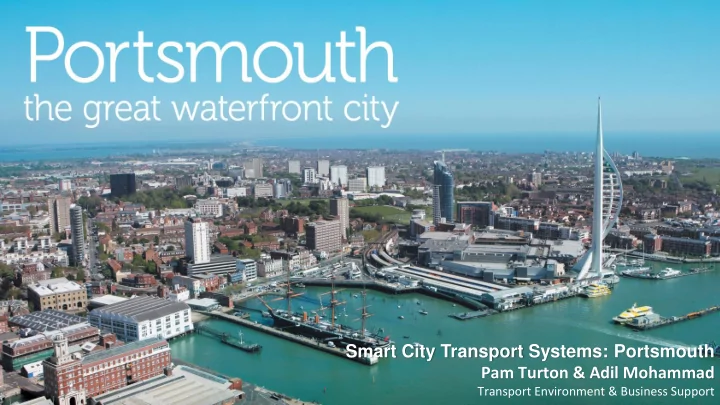

Smart City Transport Systems: Portsmouth Pam Turton & Adil Mohammad Transport Environment & Business Support
Aim To develop and implement cutting edge technology to deliver improved, consistent journey times for all modes, harnessing big data to provide real-time multi modal information enabling informed journeys, and enabling a real time response, with the overall aim of improving the journey experience for all users of the transport network within Portsmouth.
Aspirations • Improved management of the current network • Support for the economic and growth strategies of the city • Improved air quality and environmental objectives • More informed decision making by members of the public through the provision of more information, leading to greater numbers of sustainable journey choices • Improved end-to-end journey experience • Improved uptake of public transport and active travel • Improved management of events within the city, both regular (e.g. football matches) and irregular (ACWS)
Public Transport • Real Time Information • Smartcard Ticketing – Solent Go – Portsmouth Park and Ride • Digitising Bus Shelter Advertising • Audio Announcements • Traveline
Hard Interchange • Integrating ‘smart’ opportunities – RTI Screens – Touch screens – Wi-fi – Beacon Technology
Cycling • Quiet Ways App • ITS – Bid: Low level cycle signals
X-Cam • XCam smart video sensor technology sites • Detects both standing and moving traffic at the junctions • interfaces with the on-street traffic signal controller • Priority can be adjusted to prevent undue delays for general traffic and and public transport.
Traffic Signal Optimisation Programme • upgrade of 11 signalised junctions • installation of MOVA detection equipment (Microprocessor Optimised Vehicle Actuation) • MOVA is designed to cater for the full range of traffic conditions
Pedestrian Facilities • Improved Pedestrian Facilities through TSOP • Upgrade of Wayfinding totems • Zebrite Beacons
TMC Upgrade: Stratos • Centralised traffic control centre with connected systems, development and implementation of innovative technology for monitoring the road network, harnessing multiple data feeds to create strategies in real time to respond to traffic (congestion and incidents) and air pollution levels within the city. • Scalable Real-Time Traffic Management System (Stratos) • Information Management and control • Journey Time Monitoring • Real-Time Car Park Information • Incident detection and management • Enhanced Traffic Modelling and prediction • Incorporation of a range of data feeds (e.g., air pollution) • Leveraging Big Data Analytics
Journey time monitoring • 5 detector units located at strategical points in the city • Enables real-time journey time monitoring
Journey Time Outputs
Parking • Car Park Counters • Possibility of a ‘where to park’ app • Wave and Pay
PCC Vehicles • Lightfoot: In-vehicle System to provide information on driver behaviour, encouraging sustainable driving techniques – Helps to reduce costs, and vehicle emissions • Tracking
Information Provision
Towards Smart City Digital Platform IoT (Internet Of Things) Infrastructure Big Data Situational Awareness, Decision support and Rapid Response System Smart City Applications Smart Mobility Model
Digital Platform Overview
Next Steps: Smart City Applications • Predict real-time traffic conditions • Dynamic route guidance systems • Cooperative ITS systems – vehicle to vehicle and vehicle to infrastructure – Visual/audible displays; • C-ITS Bids (£300k) • Low Leve Cycle Signals (£300k) • Smart Mobility Model • Visualise journeys to/from work in Portsmouth • Predictive Modelling Capability
Questions and Discussion
Recommend
More recommend